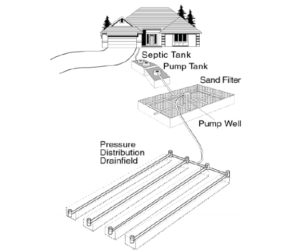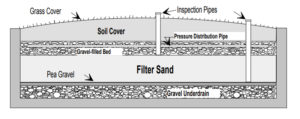Q: My home and the house next door where built in 1963. In 1981 we added a 1,000 gallon tank and two more leach lines because the contractor did not make it big enough for our family when the house was built. The county came thru later and said after everything was done that it was not legal because we did not add a sand filter. We did not change anything, just added. The system has work just fine since that time. My question is if we start having problems and have to add a sand filter, do we have to replace the whole system? — Donna L.
A: There are a variety of different sand-filter systems – some relatively simple, others quite complex that use recirculation and disinfectants to produce very clean effluent. They can be used as the primary treatment system or as a pre-filter for a conventional leach field.

Most likely, the county wants you to install a sand filter as a pretreatment system in between your septic tank and your leach field. This is one option when the leach field cannot handle the full load coming from the house due to problems such as poorly drained soils, a steep slope, excessive ledge, a high water table, or nearby waterways.
Sand filters treat the effluent by the filtering action of sand and gravel, and by oxidation and aerobic bacteria. The systems are designed for natural aeration to reach the sand filter.

A sand system requires a pumping chamber to send controlled doses of effluent to the sand filter for even distribution. In some cases, a second pump is needed to move the treated effluent to the leach field. Pump chambers use either a timer or float system to control the dosing and also include an alarm to alert you to a failure in the pump or other components.
The sand filter is most often buried, but may also be partly or fully above ground. Because this type of pre-treatment sand filter is fully lined, the type of soil underneath is not an issue. (However, a recirculating “bottomless” sand filter does discharge the effluent directly to soil beneath the filter.)
There’s a good chance that an installer can find space for the pumping station and sand filter, but that depends on the current configuration of your house, septic tank, and leach field. A single-pass filter, the simplest and most common type, can be fairly large. A licensed septic system designer could tell you pretty quickly whether this is a viable option.
Sand filters have proven to be very reliable as long as they are properly maintained and not clogged with solids. To avoid problems, practice water conservation, space out large loads like washing machine usage, and avoid putting anything down the drain that doesn’t belong such as:
- Grease, fats, meat scraps
- Paints, thinner, chemicals
- Sanitary napkins, tampons
- Paper towels, disposable diapers
- Egg shells, coffee grounds, nut shells
- Antibacterial soaps, antibiotics
Also, you will need to pay more attention to regularly pumping of the septic tank and inspection of the system. The more moving parts, the more there is to go wrong. A service contract that includes annual maintenance and inspections is a good idea. — Steve Bliss, BuildingAdvisor.com
Read More on : Alternative Septic Systems How a Septic System Works
See Also:
Are Alternative Systems Allowed?
Chamber System Failure
How Much Slope For Septic Line?
Inspecting a Septic System
Lifespan of Septic System’
Minimum Lot Size For Septic System
Perc Test Cost
Perc Test: Best Time of Year?
Replacing Failed Drain Field in Same Location
Retesting a Site That Failed to Perc
Sand Filter for Existing System
Testing an Existing Septic System
Testing for a New Septic System
Wet Sites, Septic Systems For
Who Performs Perc Test?
View all SEPTIC SYSTEM articles
Leave a Reply